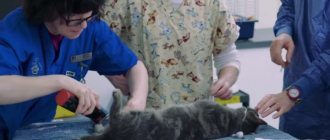Castration of a cat is a popular procedure that owners resort to for various reasons. The advantages of this operation are obvious: castrated cats behave less aggressively and usually stop marking their territory. If you let your cat outside, he will stop running away and taking part in fights for the attention of a beautiful cat. When keeping animals together, it is also extremely important that a castrated cat cannot become a father.
But, of course, any operation is a trauma for the animal. Therefore, owners often ask whether it is possible to castrate a cat using a gentle method. The veterinary clinic uses the least traumatic method of performing this operation - seamless castration of the cat using the open method.
What it is? Does your cat need neutering?
Castration of a cat is an operation to remove the gonads from an animal.
Castration differs from sterilization of a cat in that the doctor, after removing hair in the scrotum area, makes incisions and cuts off the spermatic cords and removes the testes. The operation takes place under general anesthesia.
First of all, you need to know that after reaching full sexual maturity, cats (in our case male cats) need to reproduce. It's instinct. The full life of a pet with all the inherent joys of a cat, alas, is available only in natural conditions (for example, in the private sector), while a closed apartment does not allow one to lead the usual animal lifestyle.
The result of such dissonance is often the animal’s plaintive cry during a period of hormonal surge, increased aggressiveness, and damage to property. The cat may literally begin to throw itself at the walls, try to escape from the apartment, jump out of the window or escape through the balcony. In this way, the animal splashes out unrealized energy. The operation allows you to stop this torture and restore calm to the cat.
What if you let the cat go for a walk?
This is one of the possible options, however, it is unsafe. And not only for the animal itself, but also for its owners. The fact is that relationships with stray cats (and these are the ones that most often come across in a male’s path) are fraught with infection with various diseases, including STDs and viral infections that are dangerous to humans. In addition, after communicating with friends, the cat may bring parasites into the house, which you will then get tired of removing. So if you choose a bride for a reveler, then only from the noble ones. But, unfortunately, there are very few of them.
Sometimes, of course, the cats themselves are distinguished by a calm, phlegmatic temperament and do not show any need for relationships. They really don't need surgery. But there are perhaps 1 in 1000 such unique people. If yours is not one of them, then surgery will be the optimal solution under the current conditions.
Age of castration
A responsible felinologist makes a decision to deprive a cat of his male dignity at the optimal time, and an irresponsible one makes a decision when he gets tired of the pet’s tricks.
When choosing an age suitable for celibacy, proceed from the following considerations:
- it is advisable to have time before the first mating, otherwise the pet that has acquired sexual experience will retain it for at least six months after emasculation;
- The cat must be dewormed and vaccinated.
If all the specified conditions are met, the optimal age for castration is considered to be 7–9 months. If the owner decides to castrate a sexually mature pet, it is necessary to conduct an examination to ensure that there are no contraindications to the operation.
When should cats not be castrated, and when can they be castrated?
Veterinarians recommend orchidectomy for pets at 7–9 months of age. It’s not possible until seven, because active growth is taking place, the formation of all the vital systems of the animal.
After nine is undesirable, because the process of puberty of the pet is completed (testosterone is produced not only in the testicles, but also in the endocrine glands). Castration of a cat is carried out at the request of the owner, as well as according to indications. The latter include:
- congenital anomalies (cryptorchidism);
- hereditary pathologies;
- genital injuries;
- malignant/benign neoplasms;
- other.
However, not all pets can be neutered. Castration of a cat without anesthesia is not resorted to with anesthesia if the animal is weakened. A medical exemption is given if he needs to be vaccinated in two weeks, and the two-week period has not passed since the last vaccination.
Orchidectomy is not performed on animals that have a history of liver dysfunction or renal dysfunction. It is prohibited for pets suffering from respiratory and heart diseases.
How to determine when it's time?
Cat owners most often turn to castration of their pet after much deliberation. But a decision must be made even before the little robber appears in the family.
- If an animal is purchased as a pet and has no breeding value, then it must be castrated as planned, upon reaching the age of nine months;
- it’s time to make a decision about an unplanned orchiectomy even if the animal constantly marks its territory, shows aggression towards household members, if the threat of escaping from home is real;
- Another reason for castration may be a tumor on the testicles, which must be removed.
Expert opinion
According to experienced veterinarians, castration is considered quite simple and does not have any negative consequences. However, if a more mature cat has to be castrated, then anesthesia during the operation can play a decisive role. The health of an old animal is much weaker than that of a young one. Based on this, there is a risk that it is worth noting again that any complications may occur during the process of the pet recovering from anesthesia. In general, today there are few veterinarians who oppose castration of cats.
How will spaying and neutering a kitten help?
Sterilization and castration of a kitten is a safe operation, provided that it is carried out by a specialist in a veterinary clinic. These procedures have many advantages.
Both methods help control the cat population. For example, spaying and neutering outdoor cats helps reduce the number of homeless animals.
Since castration involves the removal of genitals, there are health benefits:
- Males have a reduced risk of contracting feline immunodeficiency virus (this is like human HIV).
- Neutering prevents testicular cancer and prostate problems in males.
- Neutering prevents uterine infections and mammary tumors in cats.
- It is less likely that your pet will run away from home in search of a partner.
- Most cats stop marking their territory and become generally calmer.
Methods of cat castration - which one to choose?
Orchidectomy (castration) is a standard procedure that suppresses libido and corrects the behavioral manifestations of a cat’s sexual activity. In veterinary practice, a distinction is made between chemical and surgical methods of influencing the testes.
- Cute dog breeds
- The richest animals
- Cat claw attachments
- Dog
- Long-eared cats
- Cat meowing
Surgical methods of cat castration
Any of the surgical methods of castration has its own nuances, ranging from the surgical technique to the effect on the process of regeneration of damaged tissues and the post-castration existence of the animal. All surgical procedures are performed under general anesthesia (routes of anesthesia: inhalation, intravenous or intramuscular).
- Bloody
Methods:
- closed method. The scrotum is dissected to the vaginal membrane (the skin, the muscular-elastic layer, and fascia are cut), it is dissected without opening it to the inguinal ring, and then it is compressed together with the spermatic cord or tied with a ligature. The spermatic cord and tunica vaginalis are cut below the ligature;
- open method (“classical castration”). The scrotum and vaginal membrane are cut, the transitional ligaments are crossed with scissors, the testes and appendages are cut off by ligating, unscrewing or tearing off the cord.
- Percutaneous (bloodless). The main goal is to block the innervation and blood supply to the testes. The spermatic cords are crushed over their entire diameter with special forceps; within 4-5 months they atrophy and resolve. Advantages of the radical approach: affordable price of the operation, short postoperative period, the cat’s sexual functions are not restored. Cons: likelihood of complications after anesthesia/surgery.
- Vasectomy (sterilization). A simple and effective operation in which segmental bilateral ligation of the vas deferens is performed, as a result of which the cat becomes sterile. Pros: preservation of the testes, low trauma (manipulations are performed under local anesthesia).
Minuses:
- high price;
- careful postoperative care of the animal is required for 10-12 days;
- not every veterinarian will undertake to perform the operation due to its complexity;
- vasectomy does not affect the production and distribution of testosterone (the animal retains normal sexual responses and the ability to mate).
Chemical methods of cat castration
There are several methods of chemical castration:
- Irradiation. It involves the effect of radiation on the cat’s reproductive organs (testicles), leading to a sharp decrease in sexual activity. The dose is selected individually, based on the size and age of the animal.
- Drug contraception. Drugs based on megestrol acetate (Pillkan, EKS-7.5, EKS-5) are injected into the cat’s body by injection or in the form of tablets, which indirectly affect the regulation of behavioral manifestations and suppress sexual heat.
- Temporary chemical castration. A method of suppressing the reproductive function of a cat with the possibility of subsequent restoration. A biologically compatible implant such as Suprelorin is inserted under the skin of the male. It contains Deslorelin, which suppresses the animal’s sexual desire for a long time. The expected result is achieved 6-7 weeks after the injection. This procedure is in little demand due to the limited availability of drugs and the high cost of chemical castration. Advantages of the alternative approach: no preparation, rehabilitation period, or anesthesia is required. Disadvantages: reversibility of castration, danger of radiation exposure, significantly increases the risk of developing inflammatory processes and neoplasms.
Each of the methods of suppressing the sexual function of an animal can be applicable, since their safety and effectiveness prevail over the disadvantages. But still, the most reliable is surgical castration. Removal of the testes not only provides a 100% guarantee, but also significantly prolongs the full life of the animal, preventing such serious pathologies as deep injuries to the spermatic cords, scrotum, testicular tumors, orchitis. The choice of an acceptable method of castration is always up to the cat owner, but you should first consult with a veterinarian, weigh the pros and cons, and only then make a final decision.
Castration: briefly about the operation
Thanks to modern veterinary drugs, the operation process is completely painless for cats and dogs. At the preparation stage, the veterinarian administers a drug intravenously for general anesthesia, during which the animal is immersed in a controlled drug sleep. Next, the surgical field is processed: the hair on the scrotum is shaved off, and the skin is treated with special disinfectants. Through two small incisions, the doctor ties the spermatic cord and removes the testes. The duration of the operation rarely exceeds 5-7 minutes; postoperative sutures do not require special treatment and, with rare exceptions, are not removed.
In cats and bitches, the castration technique is somewhat more complicated. The operation is abdominal: the uterus and ovaries are removed through a deep incision in the abdomen in the groin area. The duration of the operation is 30-40 minutes, after which the wound is sutured and a collar or a special blanket is put on the animal, which protects the wound from scratching and licking. In recent years, laparoscopic techniques have been increasingly used, making the operation less traumatic.
How to prepare a cat for castration?
The operation is very dangerous for an animal with a weakened immune system, with diseases, etc. Therefore, first of all, you should visit a veterinarian for a thorough examination of your pet. Even if your cat is clinically healthy, the doctor still prescribes additional tests - do not resist, because this is one of the steps in preparing the cat for castration. You may need to have your blood and urine tested, visit a cardiologist and have a heart echogram or ECG done.
The animal is not fed 12-16 hours before the operation, and water is not given 3-4 hours before the operation, this is due to the fact that when applying general or local anesthesia, the stomach must be empty, otherwise vomiting may develop, which will aggravate the animal’s condition during or after operations.
Your doctor may also recommend giving your cat a laxative a day or less before surgery. This is done in order to empty the intestines so that after the operation the cat does not have the urge to go to the toilet, which can adversely affect the postoperative wound and cause pain to the pet.
How much does it cost to castrate a cat with preparation?
An orchidectomy requires your pet to undergo a veterinary examination. If during the examination the specialist has doubts about the health of the animal, he will send it for additional examination. This includes urine and blood tests, ECG, ultrasound of the genital organs and other studies.
If, as a result of the examination, the cat is diagnosed with a disease, he will be given a medical discharge and sent for treatment. Remember: consultation with a specialist, diagnosis of the animal, and therapeutic therapy are not included in the cost of castration of a cat in Moscow. Payment for all this is made in accordance with the price list of the veterinary center.
In addition to consulting a specialist, your pet will need to undergo anthelmintic treatment. A week before castration, he should be treated for parasites. You will need to separately purchase (if you don’t have) a protective collar, a carrier and a diaper. Please note: these are all unavoidable associated costs. Without them, it is absolutely impossible to prepare the animal for the surgical procedure.
Features of anesthesia, description of types of anesthesia
An important point in the operation is anesthesia. For certain health problems, such as diseases of the cardiovascular system, it is preferable to use local anesthesia. It does not put as much stress on the animal’s body as the general one.
But with local anesthesia, despite the lack of sensitivity in the operated area, additional fixation of the pet is necessary. No cat will like such manipulations. If the animal is young and strong, general anesthesia is chosen. If used correctly, it will not have any negative impact. Before choosing one or another type of anesthesia, you should provide your veterinarian with information about the cat’s past illnesses and chronic diseases.
Methods of administering anesthesia:
- Intravenous. Most often used. The optimal effect is achieved very quickly, due to blood circulation throughout the body. The animal easily recovers from such anesthesia.
- Intramuscular.
- Inhalation. Equipment for such administration of anesthesia is not available in every veterinary office. That is why this method is used quite rarely.
Stages of surgical castration
After administering anesthesia, the doctor performs the following manipulations:
- Preparation of the surgical field. Trim off all excess vegetation.
- Treatment of the operated area. Antiseptic solutions are applied to the groin area.
- Small longitudinal incisions are made on the scrotum using a scalpel. The skin is cut in two places.
- The testes are removed from the scrotum one by one. Ligatures (strong threads, often self-absorbing) are placed on the vas deferens to prevent hemorrhage.
- The spermatic ducts are cut and the testes are completely removed from the scrotum.
Typically, incisions in the scrotum are not sutured. They heal well without stitches. It is worth remembering that castration of cryptorchid cats is a more complex procedure and costs more. Cryptorchidism is an anomaly in the development of the reproductive system. Normally, a kitten's testes descend into the scrotum at the age of one and a half to two months.
Sometimes this doesn't happen. One or both testes remain in the abdominal cavity. In the future, this can lead to a number of diseases. This is why cryptorchidism is an indication for castration.
The doctor should perform a standard procedure for the testis, located in the scrotum. Another operation is performed to remove the second testis. This manipulation is longer and more complex.
The main risks of surgery are infection during surgery. In addition, if you do not put a postoperative collar on the animal, the cat will lick the operation site. This can also cause the wound to become infected.
Complications after castration
As a rule, cats, including mature ones, easily tolerate castration. Moreover, neutered pets live on average a couple of years longer compared to their non-neutered counterparts. They are less likely to develop leukemia, peritonitis, or the immunodeficiency virus.
And yet there are complications. They most often occur against the background of an untreated disease. Anesthesia provokes pathological processes, resulting in an exacerbation.
There is an opinion that castration leads to urolithiasis. In practice, this could not be proven unambiguously. Most likely, the issue here is not so much the absence of testes, but rather an incorrect diet and metabolic disorders. Cats neutered in adulthood may suffer from cardiovascular diseases due to general wear and tear of the body.
When to castrate a cat. Age recommendations.
In most countries around the world, castration is currently recommended for cats between 5-7 months of age and older. The reason for choosing 5-7 months of age is the relative safety of the anesthesia procedure. At a young age, cats have much less mature livers and kidneys than older animals, and are therefore less able to tolerate the effects of anesthetic drugs and less efficiently metabolize them and eliminate them from the body. Young animals therefore have an increased risk of suffering serious side effects, particularly liver and kidney dysfunction, as a result of general anesthesia. They should also have an increased time for post-operative recovery. For these reasons, many veterinarians prefer not to anesthetize a young kitten until at least 5 months of age.
Are there any disadvantages to castrating a cat at 5-7 months of age? Just as there are disadvantages to neutering a male cat at a very early age, there are also some disadvantages associated with neutering at 5-7 months of age: - There is a chance that an early maturing animal may be able to mate and produce unwanted kittens even at such a young age. — Owners who want to microchip their pets during anesthesia find it inconvenient to wait 5-7 months before this can be done. If the animal runs away and gets lost before this age, it may not find its way home. — Many of the behavioral problems (for example, spraying the area with urine, aggression) can appear before the time the cat is neutered. These behavioral problems, once established, can persist and remain even after the animal is neutered.
Castration of kittens at 8-16 weeks of age. Modern anesthetics for animals have become much safer and with fewer side effects. For this reason, some veterinarians now allow their clients to opt for an early age of neutering. Many serious veterinary organizations around the world support early castration of young cats, namely as early as 8-16 weeks of age. Benefits of early castration of young cats. These include the following: - The owner will not have to wait 5-7 months to have their pets neutered. -A neutered cat will not be able to reach very early sexual maturity and therefore will not be able to produce any kittens of his own. — Early castration allows breeders to sell young kittens (6-12 weeks) already neutered. This helps reduce the incidence of irresponsible breeding and the transmission of genetic abnormalities to subsequent litters. — For owners who decide to microchip their pets during anesthesia, there is no need to wait 5-7 months. - Some of the behavioral problems and problems that are usually associated with full-bodied males can be prevented altogether if the kitten has been neutered long before reaching sexual maturity (eg, urine spraying, territorial fighting). — The duration of surgery and anesthesia is much shorter for a young animal than for an adult. On average, it takes about 1 minute to neuter a male kitten around 9 weeks of age, compared to about 3-5 minutes maximum for an older male cat. — After anesthesia, recovery occurs faster. And also with less bleeding.
Disadvantages associated with early castration of young kittens. There are several other disadvantages to the procedure of castration at such an early age: - Using anesthesia at an early age will never be as safe as performing the same procedure on a more mature cat. Regardless of how safe modern anesthesia is, the liver and kidneys of young animals are considered less mature than those of older animals, and therefore less able to tolerate anesthetic drugs and metabolize them less efficiently to eliminate them from the body. - Loss of the hormone testosterone at a very early age, as a result of castration, can lead to extremely immature development of male characteristics and significantly reduce the musculature of the body. — Early neutering age prevents breeders from accurately determining which kittens will be valuable for further breeding. - Kittens castrated very early will be completely unable to extend their penis throughout their lives. This can lead to urinary hygiene problems and an increased risk of foreskin infection throughout your life.
The procedure for castrating a cat.
As mentioned earlier in the introductory section, neutering a cat is the surgical removal of a cat's testicles. During the procedure, a testicle is removed from each of the cat's testicles, along with some of the blood vessels and seminal ducts.
Visually, male castration looks like this: Image 1: This is a preoperative image of a cat's scrotum containing two round testicles. Image 2: An incision is made in the skin of the scrotum. Each testicle will be removed through its own separate incision in the scrotum. Image 3: Two removed cat testicles. You can clearly see the testis of each testicle, which is responsible for the production of testosterone, sperm and sperm maturation.
Postoperative care for a neutered cat
A cat after surgery requires special attention and care. First of all, the possibility of infection of the wound should be excluded. For this purpose, special collars and bandages are used. Painful sensations in cats disappear approximately one day after the operation. In order to alleviate his condition, you can use anesthetics purchased at specialized pharmacies.
Do not rush to purchase medications without consulting your doctor. He will recommend medications that will not harm the pet.
The younger the cat, the faster he will recover from anesthesia. In older cats, the recovery period reaches 2 days. After this time, if no complications have arisen, the animal’s condition does not differ from the preoperative one. The cat is placed in home quarantine for some time. You should not let him go outside for 10 days after the procedure. The animal's immunity will be weakened at this time. There is a high risk of catching some kind of infection.
If the cat was not vaccinated before castration, the quarantine time should be increased to twenty days.
After surgery, the animal's diet should be reviewed. During the recovery period, you should give your cat light, easily digestible food. Chicken broth, kefir, and milk will do. These products must be present in the diet of the operated cat. A good choice would be to switch to foods designed specifically for neutered cats. They are perfectly balanced and are able to maintain normal mineral metabolism in the animal’s body.
Castration of an adult cat and its possible complications
The first time after orchidectomy, your pet may experience dizziness, disorientation, lack of coordination, and weakness. He may feel thirsty and suffer from increased lacrimation.
The surgical wound immediately after the cat is castrated is swollen, edematous and painful. Soreness disappears 5–7 days after the intervention, swelling disappears after 2–4 days.
Castration of a cat rarely causes complications. Only 1% of patients experience:
- fistulas caused by ligature rejection;
- abscesses, wound suppuration;
- bleeding associated with wound damage.
The advantages of castrating a cat do not exclude the possibility that he will not encounter urolithiasis. Yes, it can develop in both neutered and non-neutered pets. However, after castration, especially early castration, the lumen of the urethra narrows. And the only measure to prevent the formation of stones in the urine is the correct selection of food.
Pet's behavior after surgery
Based on the advice of experienced veterinarians, your pet will need some time to regain its strength after castration. Typically, the recovery period in cats lasts only 1-2 days, during which the pet is in a sedentary and relaxed state. Your cat may be completely averse to eating any food, a process that may trigger vomiting. After castration, the pet will walk very unsteadily and slowly. But these are, perhaps, all the consequences of the operation, which quickly disappear, so there is no need to worry too much.
Modern veterinary medicine allows the procedure to be carried out quickly and without any special risks, if the anesthesia and age of the cats are selected correctly. During this period, the cat will need your support and attention more than ever. You need to carefully monitor your pet, because due to loss of coordination, he may accidentally fall from a height and cause some injury to himself. It is also necessary to take care of the cat and make sure that it does not suddenly freeze. To do this, during recovery days, we advise you to cover him with a blanket and place him near a warm radiator. As veterinarians write in their advice, approximately 5 hours after castration, it is necessary to give the pet a drink of clean water. Of course, this operation will exhaust the animal.
Options for castrating a cat at home
| Budget | Standard | Optimal | VIP | |
| Calling a veterinarian to your home | ||||
| Castration | ||||
| Three-component European anesthesia | — | |||
| Recovery from anesthesia | — | — | ||
| IV | — | — | — | |
| Antiviral serum | — | — | — | |
| Promotion until the end of the month | 3200 rub. 2500 rub. | 4800 rub. 3500 rub. | 5800 rub. 4300 RUR | 8800 rub. 7300 rub. |
PS A dropper and the administration of hyperimmune serums completely normalizes the animal’s condition and protects it from infectious diseases within 2 weeks.
Obesity prevention
Many owners are concerned about the question: what needs to be done to prevent their pet from gaining weight? Everything is quite simple: you need to reduce the usual portion by 10-20%. If the cat eats industrial food, you can replace the usual food with specialized food for castrates (in this case, there is no need to reduce the portion, since such food is balanced in composition). It is not recommended to feed the cat the same foods that are harmful to any cat: raw fish, fatty and salty foods, sausages, flour, sweets.
Benefits of the procedure
Owners are not always ready to neuter their pets. Men may be especially hostile to this procedure. Despite outbursts of feelings of solidarity and concern for the safety of the cat’s personality, castration is still worth carrying out if the animal is not intended for breeding. The operation relieves the male of suffering caused by unrealized sexual instinct. The owner gets a calmer pet and does not have to worry about regular screams and smelly marks in the apartment (house).
Removing the testes or stopping their work does not always radically change the behavior of the animal. It is believed that a neutered cat turns into a lazy carcass, focused only on food. In reality, the male often retains his previous character traits such as playfulness and activity. Aggression provoked by the production of male sex hormones is significantly reduced. Castration, like sterilization of females, potentially prolongs the life of a pet, reducing the risk of developing diseases of the genitourinary system. The procedure reduces the cat's activity, so that he is less likely to want to go outside. That is, the likelihood of a male dying under the wheels of a car or in a fight for a partner decreases.
Is it necessary to leave the testes?
In general, one of the main arguments of opponents of castration is the argument that “the cat will not feel full.” This is stupid because you shouldn't humanize animals, no matter how much you love your pets. The cat certainly won’t classify himself as “inferior.” This is the first thing. Secondly, the objective argument about improving the health of the animal tenfold covers all the far-fetched pretexts caused by the humanization of pets. It has been repeatedly proven that full castration (that is, not a vasectomy or drug-induced infertility) greatly reduces the risk of developing oncological pathologies of the genitourinary system, which is already important.
But! There are times when an animal's body needs sex hormones . Firstly, this applies to professional breeders who have put the process of producing purebred kittens on stream. It is important to know when a cat is ready for mating and is guaranteed to let the cat near her. For such cases, “probes” are needed. These are males who have had a vasectomy. They cannot fertilize a female, but they can carry out mating, and the latter is a completely transparent “hint” that your pet is ready to mate.
The second case is castration of an old cat. In general, veterinarians do not recommend sterilizing animals in old age unless absolutely necessary. Again, owners may only want to prevent their pet from having kittens. It is in these cases that a vasectomy may be appropriate. Removing the testes in order to reduce the risk of cancer at this time is already pointless, and a sharp change in hormonal levels is clearly not going to benefit the health of an “aged” cat.
Disadvantages of the operation
There are a number of potential dangers of castration. Thus, with surgical removal of the testes, there is a possibility of cryptorchidism, when one testicle remains in the abdominal cavity. As a result, the production of hormones that affect the cat’s sexual behavior continues, and repeated intervention is required.
The operation does not guarantee the cessation of attraction to the opposite sex. Males may remain interested in females. This usually does not cause problems, since the animal cannot impregnate its partner. But sometimes, along with attraction, the habit of marking territory persists. It is usually present when the function of the testes is inhibited, since their removal ensures the cessation of hormone production.
Castration is a desirable procedure for cats whose owners do not want to worry about their offspring. Veterinarians offer several ways to suppress sexual function. The most reliable, affordable and safe method is to remove the testes. But the owner may consider “bloodless” ways to suppress their functions.
The cat marks castration
The most common reason why cats are neutered is because they are marking their territory. Castration at a young age prevents or solves this problem.
Does a cat mark after castration? Do cats mark after castration? A cat yells after castration. After castration, a cat asks for a cat.
After castration, hormones leave the body gradually - over about 6 months. During this time, it is possible to maintain sexual behavior. Subsequently everything goes away.
It is extremely rare that due to the production of sex hormones by the adrenal glands, it is possible to maintain sexual behavior after castration - these are very rare cases.
In other cases, negative behavior is not associated with sexual instinct and it is necessary to look for ways to correct behavior.
Cost of the operation
For owners planning to emasculate a cat, the cost of the procedure is of interest. This table shows approximate prices for operations in different regions.
| City | price, rub. | |||
| Healthy animals | Cryptorchids | |||
| min | max | min | max | |
| Uryupinsk | 650 | 650 | – | – |
| Rostov-on-Don | 500 | 2500 | 1000 | 2500 |
| Kazan | 1000 | 1800 | 2000 | 3800 |
| Moscow | 500 | 3000 | 2000 | 4500 |
Some clinics are most likely lying; the price of 500 rubles apparently only involves the operation, without the cost of medications. There is some relationship between the cost of services and the standard of living of the population.
The owner of a cat who has decided to castrate should not delude himself. He will have to spend much more money on diagnostic studies, vaccination, deworming, etc. He has to pay for the pleasure of communicating with an affectionate animal.
Despite the admonitions of animal rights activists, castrating a cat that is doomed to spend its entire life in an apartment is a relatively humane act. An unemasculated animal, obeying the call of nature, is capable of causing a lot of negative emotions to its owners and neighbors. Therefore, animal lovers have little choice. Castrate a cat or get another animal.
Video
Cost of cat castration in Moscow
The price of castration of a cat in Moscow at a veterinary clinic cannot be fixed. They are formed based on factors such as:
- weight and age of the pet;
- patient's health characteristics (cryptorchidism/no pathologies);
- location of the operation (within the walls of a veterinary institution/home);
- others.
At the same time, the type of drugs used in orchidectomy is of great importance for pricing. The list of services included in it is important. The level of professionalism and experience of veterinary clinic specialists plays a certain role.











